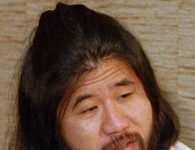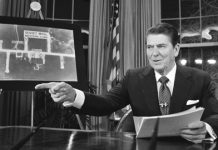On March 1, 1954, Puerto Rican nationalists opened fire on the House of Representatives, injuring five congressmen.
Nationalists Attack Congress
Three members of the Puerto Rico Nationalist Party—Lolita Lebron, Irving Flores Rodriguez and Andres Figueroa Cordero—purchased a one-way train ticket from New York to Washington, D.C., on March 1, 1954, where they met colleague Rafael Cancel Miranda.
The four entered the gallery of the U.S. House of Representatives to view the 243 congressmen in session. After watching the proceedings for about a minute, they took out their German automatic pistols and began firing into the chamber, as Lebron shouted, “Puerto Rico is not free!” The bullets injured five congressmen, all of whom would survive. Alvin Bentley, the 35-year-old Michigan Republican, was hit in the chest and suffered the worst wounds.
The 34-year-old, attractive Lebron, wearing bright lipstick and “high heels, dangly earrings, a stylish skirt and jacket, a kerchief around her neck” waved a Puerto Rican flag and headed for the exit with the two other shooters, according to Washington Post Magazine. A clerk, a page boy and three congressmen helped apprehend and disarm the four perpetrators, who were all members of the Nationalist Party of Puerto Rico, which was also involved in the attempted assassination of Harry Truman in 1950.
Police uncovered a handwritten note in Lebron’s purse that read: “Before God and the world, my blood claims for the independence of Puerto Rico. My life I give for the freedom of my country…The United States of America are betraying the sacred principles of mankind in their continuous subjugation of my country…I take responsible for all.”
The Attackers and Their Motives
Lebron was the leader of the mission. She became a follower of Harvard-educated Puerto Rican nationalist leader Pedro Albizu Campos while she was living in New York. Campos was arrested for masterminding the 1950 attempt on Truman’s life. The ire of the nationalists was amplified in 1952, when “Puerto Rico’s first elected governor, Luis Muñoz Marin, signed the island’s commonwealth pact with the United States, creating the much-debated political structure that still exists today,” according to the Post.
The United Nations officially stopped calling Puerto Rico a colony the next year. Miranda, one of the attackers, said that Puerto Ricans appeared like “happy slaves” in the eyes of the world.
At her trial, “Lolita testified that she aimed her gun at the ceiling, and the jury believed her,” according to the Post. The jury would acquit her of the most serious charge against her, “assault with intent to kill,” although she was convicted of others.
President Jimmy Carter freed the four in 1979 as part of an agreement with Fidel Castro to secure the release of American CIA agents imprisoned in Cuba.
Lebron’s religious faith deepened while in prison and reported having visions of Jesus. She did not see herself as a terrorist and “says she was horrified when planes slammed into the World Trade Center,” according to the Post. She died in 2010 at age 90.
At the time of the attack, police officials argued that bulletproof glass should be installed in the galleries of Congress, but congressmen rejected that idea because they did not want to become too separated from the public. Metal detectors were first installed in the mid-1970s following the explosion of a bomb in a Senate bathroom.
Sources in this Story
- Time: “Puerto Rico Is Not Free”
- yasminhernandez.com (The Washington Post Magazine): A Terrorist in the House
- NPR: Remembering Puerto Rican Activist Lolita Lebron
- Encyclopedia Britannica: Puerto Rico
- findingDulcinea: On this Day: Puerto Rican Nationalists Attempt to Assassinate Truman
- Time: Insurrection
- Library of Congress: Santiago Iglesias
- Encyclopedia of Chicago: Fuerzas Armadas de Liberaction Nactional (FALN)
Background: Political Movements in Puerto Rico
When the Spanish-American War ended in 1898, Puerto Rico was annexed to the United States. It was given the right to elect its own governor, but could not participate in presidential elections.
From the start, the political climate of the island was one of unrest. Puerto Rico’s Republican Party wanted statehood but the Union Party favored greater autonomy. The Nationalist Party gained power in the 1920s and worked for immediate independence. Meanwhile, the pro-United States Socialist Party was focused on the laboring classes of Puerto Rico.
Violence was building in the first half of the 20th century. Pedro Albizu Campos, the Harvard-educated orator, rallied the island’s nationalists and advocated for violence as the most effective means of achieving independence. According to Time magazine, “After President Roosevelt’s visit in 1934, he [Campos] shrieked: ‘Cowards, you should have received Roosevelt with bullets but you greeted him with flowers.’”
Meanwhile, Santiago Iglesias ran the Socialist Party, which he organized in 1915 to campaign for statehood. Iglesias’ party sought autonomy, not independence, and focused on improving the “economic, political, industrial, and agricultural life of Puerto Rico,” according to the Library of Congress.
On November 1, 1950, two Puerto Rican nationalists, Oscar Collazo and Griselio Torresola, tried to assassinate President Harry Truman in hopes of bringing their country closer to independence.
Secret Service agents intercepted Collazo and Torresola’s bullets, keeping Truman safe from harm. However, when the gunfire subsided, both Torresola and White House guard Leslie Coffelt lay dead at the steps of Blair-Lee House.
Later Developments: FALN
For the latter half of the 20th century, the Armed Forces of National Liberation (FALN) fought for complete independence of Puerto Rico from the United States. The group was responsible for more than 120 bomb attacks between 1974 and 1983.
In 1999, President Clinton was criticized for offering clemency to members of FALN, which the FBI recognizes as a terrorist organization, under the condition that they renounce all acts of violence.











